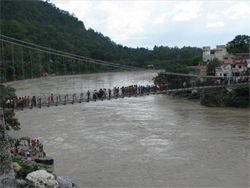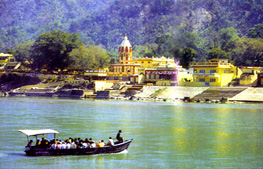|
A part of Uttar Pradesh has been separated and formed into a new state
Uttarkhand on November 9th
2000. The details given here are before the separation.
Uttar Pradesh shares an international border with Nepal
to the north along with the Indian state of Uttarakhand, Himachal Pradesh
to the north-west, Haryana, Delhi and Rajasthan on the west, Madhya Pradesh
on the south, Chhattisgarh and Jharkhand on the south east and Bihar on
the east. Situated between 23o 52'N and 31o 28 N
latitudes and 77o 3' and 84o 39'E longitudes, this
is the fourth largest state in the country.
Physical Features
Uttar Pradesh can be divided into three distinct hypsographical
regions :
-
The Himalayan region in the North
-
The Gangetic plain in the centre
-
The Vindya hills and plateau in the south
The Himalayan region comprises the districts of Uttarkashi,
Chamoli, Pithoragarh, Tehri-Garhwal, Garhwaland Almora and Nainital
tehsil of Nainital district and Chakrata and a part of Dehra Dun tehsil
of Dehra Dun district. High mountains formed of sedimentary rocks
broken by valleys and deep gorges, characterize the terrain. The perpetual
snows in the higher reaches are the source of perennial rivers and rivulets
which criss-cross the terrain and ultimately find their two rivers together
with their tributaries form a big river system which waters the entire
Gangetic plain.  The
prominent peaks in the hill region include Banarpunch, Mount Kamety, Trishul,
Dunagiri, Nanda Devi, Badrinath and Kedaranath. The hill areas
are sparsely populated. Due to the excessively nature of the terrain,
soil is subject to heavy erosion. Cultivation is done under intensive
soil. Irrigation facilities are deficient and only a small fraction of
the total area is under artificial irrigation. The valley area have fertile
and rich soil. There is an intensive cultivation on terraced hill slopes.
The higher altitudes are suitable for sub-tropical and temperate
fruit culture. The Siwalik range which forms the southern foothills of
the Himalayas, slopes down in to a boulder bed called 'bhadhar'. The transitional
belt running along the entire length of the state is called the terai
and bhabhar area. It has rich forests, cutting across it are innumerable
streams which swell into raging torrents during the monsoon. The
bhabhar tract gives place to the terai area which is covered with tall
elephant grass and thick forests interspersed with marshes and swamps.
The sluggish rivers of the bhabhar deepen in this area, their course running
through a tangled mass of thick under growth. The terai runs parallel
to the bhabhar in a thin strip. The main crops are wheat, rice,
and sugar cane. Jute also is grown. Tea is grown in the sub mountain area
of the Dehra Dun. The
prominent peaks in the hill region include Banarpunch, Mount Kamety, Trishul,
Dunagiri, Nanda Devi, Badrinath and Kedaranath. The hill areas
are sparsely populated. Due to the excessively nature of the terrain,
soil is subject to heavy erosion. Cultivation is done under intensive
soil. Irrigation facilities are deficient and only a small fraction of
the total area is under artificial irrigation. The valley area have fertile
and rich soil. There is an intensive cultivation on terraced hill slopes.
The higher altitudes are suitable for sub-tropical and temperate
fruit culture. The Siwalik range which forms the southern foothills of
the Himalayas, slopes down in to a boulder bed called 'bhadhar'. The transitional
belt running along the entire length of the state is called the terai
and bhabhar area. It has rich forests, cutting across it are innumerable
streams which swell into raging torrents during the monsoon. The
bhabhar tract gives place to the terai area which is covered with tall
elephant grass and thick forests interspersed with marshes and swamps.
The sluggish rivers of the bhabhar deepen in this area, their course running
through a tangled mass of thick under growth. The terai runs parallel
to the bhabhar in a thin strip. The main crops are wheat, rice,
and sugar cane. Jute also is grown. Tea is grown in the sub mountain area
of the Dehra Dun.
The most important area for the economy of the state
is the Gangetic plain which stretches across the entire length of the
state from east to west. The entire alluvial plain can be divide into
three sub-regions. The first in the eastern tract consisting of
14 districts which are subject to periodical floods and droughts and have
been classified as scarcity areas. These districts have the highest
density of population which gives the lowest per capita land. The
other two regions, the central and the western are comparatively better
with a well-developed irrigation system. They suffer from water logging
and large-scale user tracts. The Gangetic plain is watered by the Jamuna, the Ganga and its major tributaries,
the Ramganga, the Gomati, the Ghaghra and Gandak. The whole plain is alluvial
and very fertile. The chief crops cultivated here are rice, wheat, millets,
gram, barley Sugar cane is the chief cash crop of the region. The Southern
fringe of the Gangetic is demarcated by the Vindhya hills and plateau.
It comprises the four districts of Jhansi, Jalaun, Banda, and Hamirpur
in Bundelkhand division, Meja and Karchhana tehsils of Allahabad
district, the whole of Mirzapur district south of Ganga and
Chakia tehsil of Varanasi district. The ground is strong with low hills.
The Betwa and Ken rivers join the Jamuna from the south -west in this
region. It has four distinct kinds of soil, two of which are agriculturally
difficult to manage. They are black cotton soil. Rainfall is scanty and
erratic and water -resources are scare. Dry farming is practical on a
large scale.
The Gangetic plain is watered by the Jamuna, the Ganga and its major tributaries,
the Ramganga, the Gomati, the Ghaghra and Gandak. The whole plain is alluvial
and very fertile. The chief crops cultivated here are rice, wheat, millets,
gram, barley Sugar cane is the chief cash crop of the region. The Southern
fringe of the Gangetic is demarcated by the Vindhya hills and plateau.
It comprises the four districts of Jhansi, Jalaun, Banda, and Hamirpur
in Bundelkhand division, Meja and Karchhana tehsils of Allahabad
district, the whole of Mirzapur district south of Ganga and
Chakia tehsil of Varanasi district. The ground is strong with low hills.
The Betwa and Ken rivers join the Jamuna from the south -west in this
region. It has four distinct kinds of soil, two of which are agriculturally
difficult to manage. They are black cotton soil. Rainfall is scanty and
erratic and water -resources are scare. Dry farming is practical on a
large scale. |

